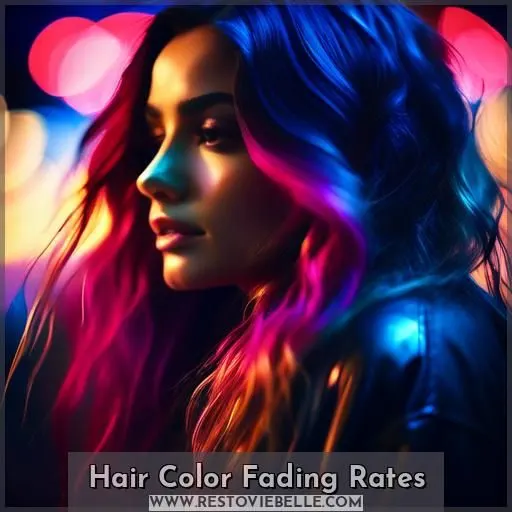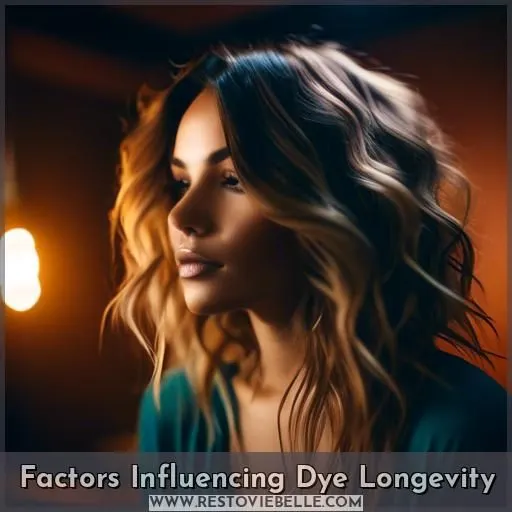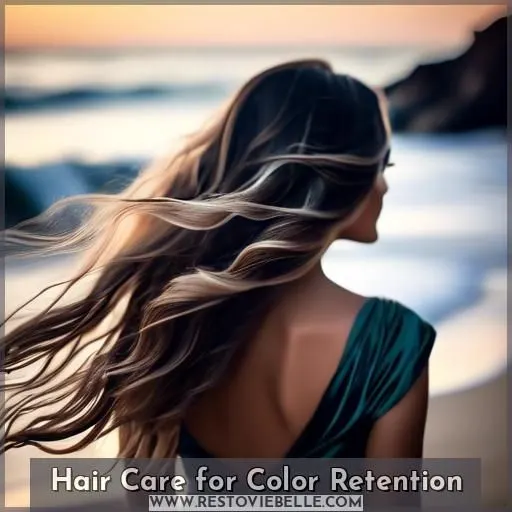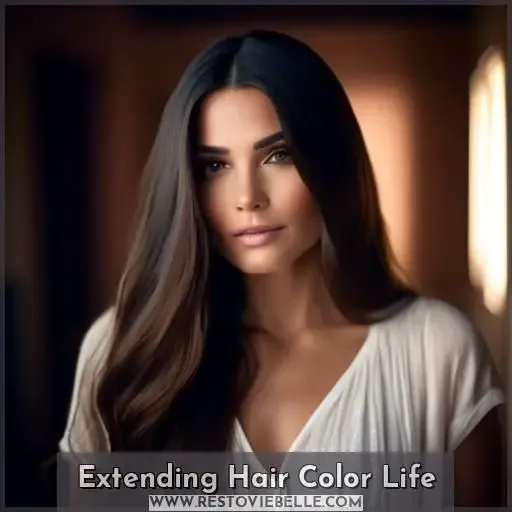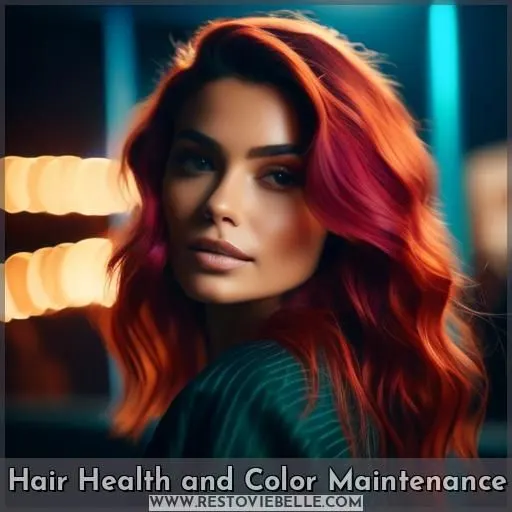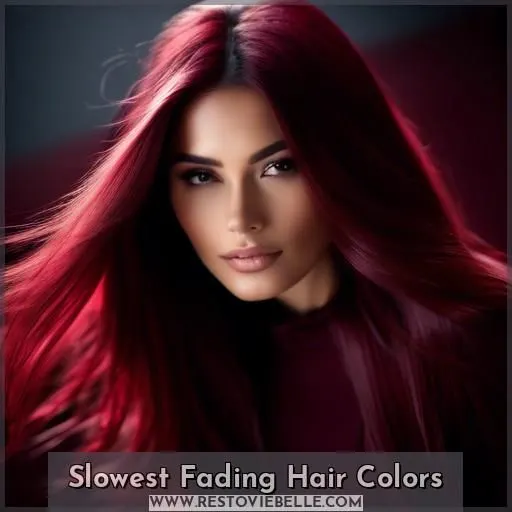This site is supported by our readers. We may earn a commission, at no cost to you, if you purchase through links.
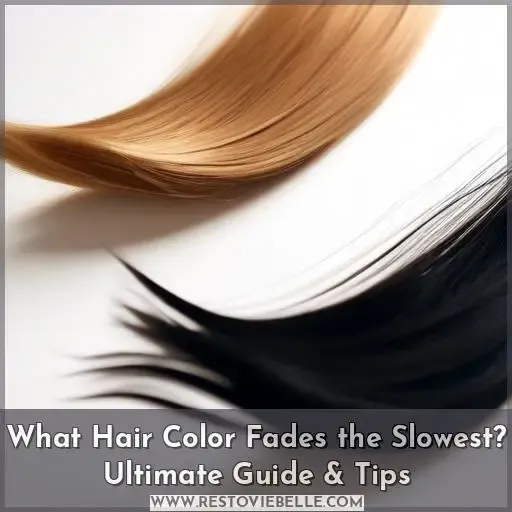 Maintaining vibrant hair color demands strategic choices.
Maintaining vibrant hair color demands strategic choices.
Darker shades like black and brown contain smaller dye molecules that penetrate strands deeply, ensuring superior longevity compared to lighter tones.
By understanding how hue selection impacts fading rates, you’ll achieve low-maintenance locks.
This guide unveils the slowest-fading colors, empowering you to maximize vibrancy between salon visits effortlessly.
Table Of Contents
Key Takeaways
- Darker hair colors, such as black and brown, contain smaller dye molecules that penetrate strands deeply, ensuring superior longevity compared to lighter tones.
- Red hair color fades the fastest due to its large molecules that are easily removed by water.
- Darker pigments in hair color, such as black, brown, and dark red, tend to fade slower than lighter shades.
- To maintain vibrant hair color, use sulfate-free shampoo and conditioner, avoid heat styling tools, and use a color-safe leave-in conditioner or serum.
What Hair Color Fades the Slowest?
Darker hair colors like brown and black fade the slowest because their small color molecules penetrate deeply into the hair shaft. This makes them more durable and less prone to fading compared to lighter or more vibrant colors.
Hair Color Fading Rates
Dark hair colors fade more slowly compared to lighter ones, as the smaller molecules of darker dyes penetrate deeper into the hair shaft, providing lasting color retention. Conversely, red hair color fades the fastest due to its large molecules that are easily removed by water.
Dark Vs. Light Shades
Darker pigments in hair color, such as black, brown, and dark red, tend to fade slower than lighter shades. This is due to the small molecules in darker colors that penetrate the hair deeply, creating a more robust bond with the hair shaft. In contrast, lighter colors like blonde have larger molecules that can’t penetrate as deeply, resulting in faster fading.
Blonde hair can be challenging to maintain, as it’s prone to fading and turning brassy. To keep blonde hair looking fresh, use purple shampoo and conditioner to neutralize brassy tones. Additionally, use a heat protectant spray before using heat styling tools, and avoid over-washing hair to prevent color from fading.
Brunette hair color is relatively easy to maintain, with darker shades of brown lasting longer than lighter shades. To preserve brunette hair color, use gentle shampoo and conditioner formulas, avoid heat styling whenever possible, and use a leave-in conditioner or serum to lock in moisture.
Red hair is one of the hardest colors to maintain, as it fades fastest due to large molecules that are easily removed by water. To keep red hair vibrant, use sulfate-free shampoo and conditioner, avoid heat styling tools, and use a color-safe leave-in conditioner or serum.
Permanent dyes generally last longer than semi-permanent dyes, as they penetrate the hair shaft more deeply. However, even permanent dyes can fade over time, especially in porous hair or with frequent shampooing. To extend the life of your hair color, avoid harsh chemicals, use color-safe products, and protect your hair from the sun with hats or UV protection sprays.
Red Hair Vulnerability
Red hair color is known for its vibrancy and intensity, but it can also be challenging to maintain.
- Use sulfate-free shampoo and conditioner: Sulfates can strip your hair of color, so opt for sulfate-free products to help preserve your red hue.
- Avoid heat styling tools: Heat can damage your hair and cause color to fade. If you must use heat styling tools, use a heat protectant spray to minimize damage.
- Use a color-safe leave-in conditioner or serum: These products can help protect your hair color and keep it looking vibrant.
- Get regular trims: Split ends and damaged hair can cause color to fade more quickly. Regular trims help maintain the health of your hair.
- Avoid over-washing: Washing your hair too often can strip it of color. Aim to wash your hair no more than twice a week.
Permanent Vs. Semi-Permanent Dyes
When it comes to hair dye, the choice between permanent and semi-permanent dyes can significantly impact the longevity and maintenance of your color. Permanent dyes, as the name suggests, penetrate the hair shaft and last longer, while semi-permanent dyes sit on the hair shaft and fade over time.
- Permanent dyes generally last longer and require less frequent touch-ups.
- Semi-permanent dyes are ideal for those who want to experiment with temporary colors or maintain a low-maintenance look.
- Always follow the manufacturer’s instructions for application and maintenance.
- Regular trims and deep conditioning treatments can help maintain color vibrancy.
- Avoid harsh chemicals, heat styling, and excessive washing to extend dye longevity.
Incorporate these strategies into your hair dye routine to unlock the secrets of long-lasting, low-maintenance color.
Factors Influencing Dye Longevity
Your natural hair color plays a crucial role in dye longevity: bleaching can accelerate fading, while darker natural shades better retain color. The type and quality of hair dye you choose also impact its lifespan; permanent dyes typically last longer than semi-permanent options.
Natural Hair Color Impact
Your natural hair color, determined by genetics, plays a significant role in how long your hair color lasts. Porosity, a measure of your hair’s ability to absorb and retain moisture, is influenced by your hair’s natural texture, color history, styling habits, and environmental exposure. High porosity hair, which is more common in fine, thin, or curly hair, can lead to over-absorption of color, causing darker, duller color outcomes and rapid color fade.
To maintain your hair color, it’s essential to consider your hair’s porosity level when selecting products and styling techniques. For example, high porosity hair may benefit from using a pre-color treatment to even out porosity before coloring. Additionally, using sulfate-free shampoos and conditioners can help protect your hair’s natural moisture balance.
Hair Dye Type and Quality
Diving into the world of hair dye, it’s clear that not all colors are created equal.
The type of dye you choose—be it permanent or semi-permanent—plays a huge role in how long your vibrant hue sticks around.
High-quality brands often promise longer-lasting color, making your quest for low-maintenance locks a bit easier.
Post-Dye Care Importance
Post-dye care is crucial for maintaining vibrant hair color. Use protecting products like hair masks, post-dye conditioning, and deep treatments. Leave-in treatments and leave-in conditioners can also be beneficial. Protect your hair from UV rays, as what hair color fades the slowest is influenced by sun exposure.
Hair Care for Color Retention
To preserve your vibrant hue, you must adopt a meticulous hair care regimen that shields it from external aggressors and nourishes it from within. This involves employing sulfate-free shampoos, minimizing heat styling, and implementing UV protection measures to safeguard your color’s longevity.
Sulfate-Free Shampoos
Sulfate-free shampoos are a game-changer for maintaining vibrant hair color.
These color-safe formulas are designed to gently cleanse your hair without stripping it of its natural oils.
Sulfate-free shampoos are essential for all hair colors, including brown, purple, black, blue, and brunette.
They help retain moisture, prevent color fading, and protect hair health.
By choosing sulfate-free shampoos, you’re taking a step towards a more robust hair care routine that underpins the longevity of your hair color.
Heat Styling Precautions
Heat styling tools can be a double-edged sword for hair color. On the one hand, they can enhance your locks and give them a glossy finish. On the other hand, they can also cause heat damage, which can lead to color fading and overall hair health issues.
- Use a heat protectant spray or serum: Before using any heat styling tool, apply a heat protectant product to create a barrier between your hair and the heat, minimizing damage and color loss.
- Opt for heat-free styling methods: Whenever possible, choose heat-free styling methods like air-drying, braiding, or using foam rollers to reduce heat exposure and color fading.
- Wash your hair less frequently: Washing your hair less often helps preserve the color by reducing exposure to water and shampoo.
- Protect your hair from the sun: Wear a hat or use UV-protective hair products when spending time outdoors to shield your hair from the sun’s harmful UV rays.
- Regular color touch-ups: Schedule regular touch-up appointments with your professional colorist to maintain the vibrancy of your hair color and cover any regrowth or fading.
UV Protection Strategies
Protect your hair color from the sun’s harsh rays with these UV protection strategies. Wear hats or use heat protector sprays when outdoors. Apply sunscreen to your scalp and use color-safe hair products.
Navigate the complexities of hair care with ease. It’s not merely about avoiding fading; it’s about enhancing your hair’s health and vibrancy.
Extending Hair Color Life
To extend your hair color’s life, you can start by washing your hair less frequently. This will help to preserve the color and prevent it from fading too quickly. Additionally, you should avoid chlorine and saltwater, as these can also strip away color.
Frequency of Washing
To extend the life of your hair color, adjust your washing routine.
Opt for cooler water temperatures, as hot water can strip color from your hair.
Try using a color-depositing shampoo or conditioner, or a leave-in conditioner to keep your color vibrant.
Washing your hair less frequently can also help.
If you must wash, consider using a hair mask or a color-depositing shampoo to replenish your color.
Chlorine and Saltwater Exposure
To prevent hair color fading from chlorine exposure, consider these tips:
- Rinse your hair with fresh water before entering the pool: This helps your hair absorb more pure water and less chlorine.
- Apply a thin layer of leave-in conditioner: It acts as a barrier, preventing chlorine from sitting on your hair.
- Use a swim cap: It’s your last line of defense against chlorinated water.
- Rinse your hair thoroughly with fresh water and mild shampoo after swimming: This removes chlorine and replenishes moisture.
- Apply a leave-in conditioner or hair serum: These products help restore moisture and protect your hair from chlorine damage.
Dry Shampoo Benefits
Dry shampoo can be a game-changer for extending the life of your hair color. It absorbs excess oil and adds volume, making your hair look cleaner and more vibrant between washes.
- Choose the right dry shampoo: Look for a product that suits your hair type and color. Opt for formulas that are free of harsh chemicals and designed for color-treated hair.
- Apply it correctly: Spray dry shampoo directly onto your roots, holding the can about 6 inches away from your head. Be sure to avoid the scalp to prevent irritation.
- Let it settle: Allow the dry shampoo to sit for a minute or two to absorb the excess oil.
- Brush it out: Use a soft-bristle brush to gently remove any visible residue. This step is crucial to prevent buildup and maintain the health of your hair and scalp.
- Avoid overuse: Dry shampoo isn’t a replacement for regular shampooing. Use it sparingly, no more than twice a week, to prevent potential scalp irritation and hair breakage.
- Maintain a balanced routine: Continue washing your hair with a gentle, color-safe shampoo and conditioner at least once or twice a week to keep your scalp healthy and your hair color vibrant.
By incorporating dry shampoo into your hair care routine, you can enjoy the benefits of extended color longevity without compromising the health of your hair.
Hair Health and Color Maintenance
To maintain vibrant hair color, your hair’s health is paramount. Regular trims remove split ends, preventing breakage and color loss, while deep conditioning treatments restore moisture and strengthen hair, making it more resistant to fading.
Regular Trimming Benefits
Regular trims are your secret weapon in the battle for vibrant, long-lasting hair color. Think of it as pruning a garden; by removing split ends, you encourage healthy hair growth.
- Trimmed hair means less breakage and more shine.
- Split end removal keeps your locks looking fresh.
- Healthy hair growth ensures your color stays radiant for longer.
A stitch in time saves nine, and a trim in time saves your divine hue!
Deep Conditioning Treatments
Deep conditioning treatments are essential for maintaining the vibrancy and health of color-treated hair. These treatments provide intense nourishment, helping to revitalize and fortify hair that has undergone the chemical process of coloring. When choosing a deep conditioner, opt for products specifically formulated for color-treated hair, as they often contain ingredients like argan oil, keratin, and vitamins to enhance and protect the chosen hue.
Keratin treatments can also benefit color-treated hair by smoothing frizz, adding shine, and reducing blow-drying time. However, they may alter the appearance of dyed hair, potentially lightening or changing its tone. To minimize fading, wait at least two weeks between coloring your hair and getting a keratin treatment.
Protein masks and scalp protection treatments can further enhance the health and longevity of color-treated hair. Regular maintenance treatments, such as touch-ups or deep conditioning treatments, can also help extend the life of your hair color.
Remember to use sulfate-free, color-safe shampoos and conditioners to avoid stripping the hair of its natural oils and color. Additionally, avoid excessive heat styling, which can weaken the keratin bonds and cause the treatment to fade faster. Protect your hair from environmental factors like sunlight and chlorine by wearing hats or using UV-protective sprays.
Avoiding Over-Washing
To maintain the vibrancy of your hair color, it’s essential to avoid over-washing your hair.
Over-washing can lead to water damage, oil buildup, and product residue, which can irritate your scalp and cause dryness.
Aim to wash your hair every 2-3 days, or as recommended by your stylist.
Use a color-safe shampoo and conditioner, such as those formulated for color-treated hair, to help extend the life of your color.
Consider using a sulfate-free shampoo to minimize damage to your hair and scalp.
By following these tips, you can keep your hair healthy and your color looking fresh for longer.
Slowest Fading Hair Colors
Dark hair colors fade the slowest due to their deep pigment penetration, while lighter shades fade more rapidly due to larger molecules that can’t penetrate as deeply. Black and brown dyes are particularly long-lasting, making them popular choices for those seeking low-maintenance color.
Darker Shades Resilience
Darker shades of hair color, such as black and brown, are known for their resilience and slow fading rates.
This is due to the smaller molecules in these pigments that penetrate the hair shaft more deeply, creating a more robust bond.
To maintain their vibrancy, focus on meticulous maintenance, including regular trims and gentle, color-safe products.
By navigating the complexities of hair color, you can unlock the secrets to ever-evolving, low-maintenance hues that enhance your style and confidence.
Black and Brown Dye Longevity
Black and brown hair colors are known for their longevity, as they contain a higher concentration of pigments that penetrate the hair shaft more deeply, resulting in a longer-lasting color. Brunettes, in particular, can enjoy the benefits of darker shades, which often maintain their vibrancy for extended periods without requiring frequent touch-ups.
However, even with these advantages, it’s essential to maintain your hair’s health to ensure the color stays vibrant. Here are some tips for caring for black and brown hair:
- Use sulfate-free shampoos and conditioners: Sulfates can strip hair color and weigh it down, so opt for products that are gentle and color-safe.
- Avoid over-washing: Shampooing too frequently can cause color to fade, so aim to wash your hair every other day or less, depending on your hair type.
- Use cooler water: Hot water can open the hair cuticle, allowing color to escape, so rinse your hair with cooler water to help preserve the color.
- Protect your hair from the sun: Wear a hat or use a UV-protective product to shield your hair from the sun’s damaging rays.
Pastel and Vivid Colors Fading
When it comes to pastel and vivid hair colors, they are known for their temporary dye effects.
To keep these colors vibrant, consider using color-depositing products specifically designed for blonde hair care, green hair maintenance, and blue hair maintenance.
Avoid over-washing your hair.
Use sulfate-free shampoos and conditioners.
Regular trims are also essential to maintain the health of your hair and prevent color fading.
Frequently Asked Questions (FAQs)
Can diet affect hair color longevity?
You bet! A diet rich in vitamins (like B and C) and protein can help strengthen hair follicles, promoting vibrant color longer. Eat leafy greens, eggs, and lean meats to maximize that fresh-from-the-salon look.
Does hair texture influence color fade rate?
Yes, hair texture influences color fade rate. Coarse, thick hair tends to retain color longer than fine, thin hair.
Are there any natural remedies to prevent fading?
Unleash nature’s power: rinse with brewed chamomile tea or massage with coconut oil weekly – the golden elixirs shield your vibrant locks.
How does hormonal change impact hair dye?
You bet! Hormonal changes can affect hair’s texture and porosity, impacting how well dye penetrates strands. Dyes may fade faster during pregnancy, menopause, or thyroid issues. Consult your stylist for customized color care tips.
Can certain medications accelerate color fading?
Yes, certain medications like retinoids, chemotherapy drugs, and anticoagulants can accelerate hair color fading.
Conclusion
Ironic, isn’t it? Vibrant locks demand strategic color selection, yet your tresses’ hue impacts fading rates. Embrace deeper shades like black and brown; their smaller dye molecules penetrate strands profoundly, ensuring superior longevity compared to lighter tones.
Unlocking what hair color fades slowest empowers you to maximize vibrancy effortlessly between salon appointments.
